SAT Biology E/M Subject Test
Part II: Subject Review
Chapter 4 Cell Structure
According to cell theory, every living organism—plant, animal, or otherwise—is made of cells, and all cells arise from preexisting cells. The simplest organisms have one cell; they are unicellular. More complex organisms are made of many cells; they are multicellular. In this chapter, we will explore the structure of cells—the basic building blocks of life.
EUKARYOTIC CELL STRUCTURE
Look at the following diagram, and think of a cell as having three main areas: the cell wall and/or membrane, the cytoplasm, and the nucleus.
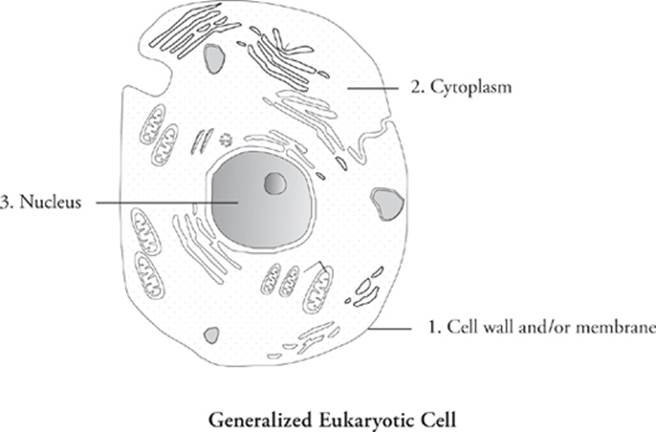
1. The cell wall and/or membrane forms the outer layer.
2. The cytoplasm or cytosol contains the organelles.
3. The nucleus, which is bounded by a nuclear membrane, contains chromosomes.
Notice that in the list, number one says “the cell wall AND/OR membrane.” It turns out that plants, bacteria, and fungi have both a cell wall and a membrane (the cell wall is the outermost portion), whereas animal cells have only a cell membrane.
More about Cell Walls
Plants, bacteria, and fungi all have cell walls, but their cell walls are made up of different substances.
• Plants have cell walls made of cellulose. Remember that cellulose is a polysaccharide.
• Bacteria have cell walls made of peptidoglycan. Peptido refers to protein, and glycan refers to sugar, so bacterial cell walls are made of protein and sugar.
• Fungi have cell walls made of chitin. Chitin is a polysaccharide that”s similar to cellulose.
More about the Cell Membrane
Remember: The cell membrane is made of
• lipids
• proteins
We learned about these molecules in the last chapter when we covered basic biological chemistry. The primary lipids found in cell membranes are phospholipids; do you remember their special characteristics? If you don”t remember, go back and review them now.
Phospholipids have both polar and nonpolar regions and form lipid bilayers:
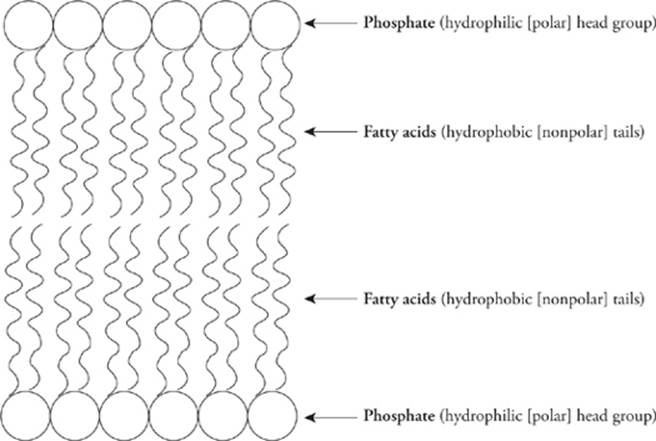
Cell membranes are just lipid bilayers. They make excellent barriers, because the inside of the cell is aqueous (watery), and the external environment of the cell is usually aqueous; so in effect, the lipid bilayer cell membrane forms an “oily” layer between the inside of the cell and the outside of the cell. Substances that are “happy” in an aqueous medium (in other words, hydrophilic substances) do not like to cross the oily (in other words, hydrophobic) barrier.
However, substances do need to get in and out of the cell—oxygen, carbon dioxide, glucose and other nutrients, and waste products, to name a few. The cell membrane lets some things through and restricts the passage of other things. For this reason, it is said to be selectively permeable.
Four Ways That Substances Can Cross the Cell Membrane
1. Simple Diffusion
Diffusion is simply the movement of a substance from an area of high concentration to an area of lower concentration until a dynamic equilibrium is reached. This is called “moving down a concentration gradient.” So if there is more of something on one side of the membrane (for example, inside the cell) and less of that same thing on the other side of the membrane (in this case, outside the cell), that substance will simply move across the membrane to the area of lower concentration (again, in this case, outside the cell). Basically, our example substance, whatever it is, relieves some of the crowding inside the cell by moving outside the cell.
Lipid Soluble Substances Only
Because the cell membrane is a lipid bilayer, simple diffusion works only if the substance in question is lipid soluble (hydrophobic) and can interact with that oily barrier. Some examples of substances that cross the cell membrane by simple diffusion are oxygen, carbon dioxide, and cholesterol.
2. Facilitated Diffusion
Facilitated diffusion is similar to simple diffusion, except that the molecules that cross are not hydrophobic. Because they are not hydrophobic, they cannot interact with the oily barrier and cannot simply cross the membrane. They need help. The proteins that make up the cell membrane can help move substances across the lipid bilayer. Because they help, or facilitate, the movement of substances across the membrane, this type of movement is called facilitated diffusion.
Comparisons: Facilitated vs. Simple Diffusion
Facilitated diffusion is like simple diffusion in one important respect: A substance crosses the membrane only if there is a concentration difference on either side of the membrane. Some examples of hydrophilic substances that cross the membrane by facilitated diffusion are sodium, potassium, calcium (in fact, all ions, because they carry a charge, must cross membranes by facilitated diffusion), and glucose. Also, both facilitated diffusion and simple diffusion are considered forms of passive transport since no energy is required on the part of the cell for the process to occur.
The proteins form specialized channels, sort of like pores, across the membrane. The channels are highly specific for particular substances—for example, a channel might allow sodium to cross but not potassium. Some proteins do not form pores but instead act as carrier molecules that bind to a substance and “pull” it through the membrane.
3. Active Transport
In active transport, the cell must expend energy to move something across the membrane. Active transport is different from simple and facilitated diffusion in this important respect: It can move a substance across the cell membrane from an area of low concentration to an area of higher concentration. That”s why it requires energy. Another way to describe active transport is to say that it moves substances against their concentration gradients. Simple and facilitated diffusion are considered passive processes because they move substances down their gradients, and this doesn”t require energy.
Active transport also relies on membrane proteins to move substances, and it doesn”t matter whether the substance is hydrophobic or hydrophilic.
4. Bulk Transport
Bulk transport is what its name implies: the movement of large, bulky items across the cell membrane. There are two possible directions to move the substances: into the cell, called endocytosis, and out of the cell, called exocytosis.
In endocytosis, the cell takes in some particle by surrounding and engulfing it within a pocket known as a vesicle. Two examples of endocytosis are phagocytosis (cell eating: amoeba surrounding a particle of food with its pseudopods; a white blood cell ingesting a pathogen) and pinocytosis(cell drinking).
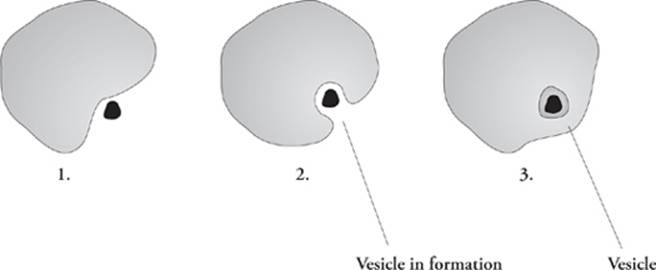
Exocytosis is the exact opposite. A particle in a cell (in a vesicle) is released to the outside by fusing the vesicle with the cell membrane.
Osmosis
Osmosis is simply the movement of water across a cell membrane, down its concentration gradient. The thing to remember, though, is that water”s concentration gradient is opposite to the solute (dissolved particles) concentration gradient. In other words, if there is a lot of some particular substance inside a cell and less of that substance outside the cell, then there is less water inside the cell and more water outside the cell. Basically, the substance takes up some room where water could be, so if there”s a lot of the substance present, then there will be less water present. In our example, water will want to move down its concentration gradient, into the cell.
Water is hydrophilic (seems obvious, doesn”t it?), so it must cross the membrane by facilitated diffusion. Cells have many water channels in their membranes that allow water to cross easily. This can cause problems if the cells are placed into solutions that are more or less concentrated than they are.
Think about a cell placed into a concentrated solution (a hypertonic solution). There are more particles outside the cell than inside, so there is less water outside the cell than inside. Water will move down its gradient, from inside the cell to outside the cell, and the cell will shrivel up.
Now think about a cell placed into a dilute solution (a hypotonic solution). There are now fewer particles outside the cell than inside, so there is more water outside the cell than inside. Water will move down its gradient, from outside the cell to inside the cell, and the cell will swell up and may burst.
If the cell is put into a solution that is exactly the same concentration as the cell itself (an isotonic solution), then the cell will neither shrivel nor swell. Human cells are isotonic (equally concentrated) to a 0.9% sodium chloride solution.
Quick Quiz #1
Fill in the blanks and check the appropriate boxes:
1. Animal cells [ ![]() do
do ![]() do not ] have cell walls.
do not ] have cell walls.
2. Bacteria have cell walls made of _________________________.
3. Engulfing large particles in a vesicle is known as ________________.
4. Facilitated diffusion is a way for [ ![]() hydrophobic
hydrophobic ![]() hydrophilic ] substances to cross the cell membrane.
hydrophilic ] substances to cross the cell membrane.
5. Fungi have cell walls made of _________________________, and plants have cell walls made of _________________________.
6. Simple diffusion [ ![]() does
does ![]() does not ] require energy.
does not ] require energy.
7. Hydrophobic substances cross the membrane by ________________.
8. A type of movement that requires energy and moves substances against their concentration gradients is called __________________.
9. A human blood cell placed in a 10% solution of sodium chloride solution will
(A) swell
(B) shrivel
(C) stay the same
(D) shrink and then swell
(E) swell and then shrink
10. Which term best describes a cell membrane?
(A) Nonpermeable
(B) Permeable
(C) Selectively permeable
(D) Impermeable
(E) Transparent
Correct answers can be found in Chapter 15.
More About the Cytoplasm
The cytoplasm is a semiliquid goo that contains a eukaryotic cell”s organelles. The organelles perform specific functions for the cell. Note that some cells (bacteria) do not have organelles and are prokaryotic. We”ll talk more about bacteria in Chapter 10.
All of the organelles except the ribosome are bounded by a membrane. Two of the organelles (the nucleus and the mitochondria) are bounded by two membranes.
Study this picture of a eukaryotic cell and its organelles, as well as the list of organelle functions that below.
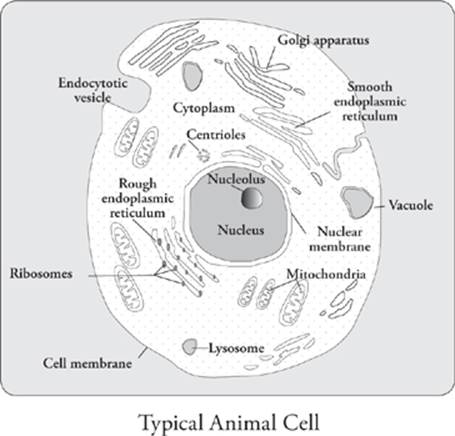
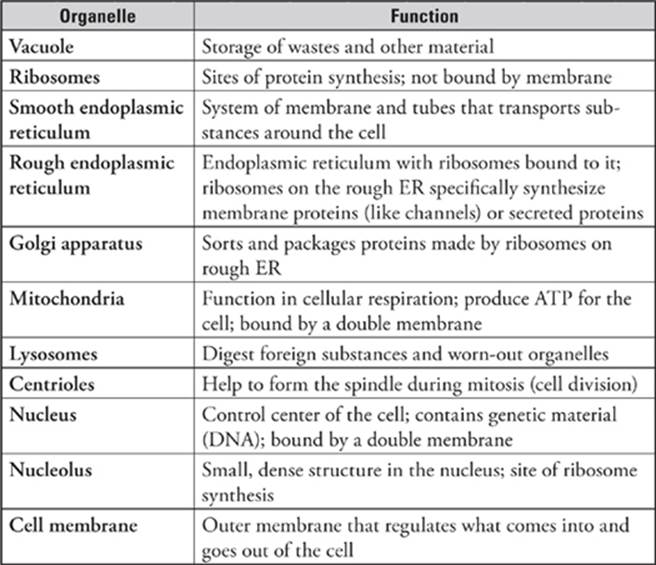
Quick Quiz #2
Match the organelle on the left with its function/description on the right.
|
1. Golgi apparatus |
A. cellular transport system |
|
2. Centrioles |
B. stores waste and other substances |
|
3. Lysosomes |
C. selectively permeable barrier that regulates what enters and exits the cell |
|
4. Rough ER |
D. site of ribosome synthesis in the nucleus |
|
5. Cell membrane |
E. related generally to formation of the spindle during mitosis |
|
6. Ribosomes |
F. cellular respiration and ATP production; has double membrane |
|
7. Nucleolus |
G. holds ribosomes that synthesize membrane or secreted proteins |
|
8. Vacuole |
H. contain hydrolytic enzymes; digest foreign substances and worn organelles |
|
9. Smooth ER |
I. contains genetic material (DNA); control center of the cell |
|
10. Mitochondria |
J. sites of protein synthesis |
|
11. Nucleus |
K. sorts and packages membrane and secreted proteins |
Correct answers can be found in Chapter 15.
What Goes On in the Cytoplasm: Chemical Reactions and Enzymes
Thousands and thousands of different chemical reactions take place in the cytoplasm. Here”s an example of a very generic chemical reaction:
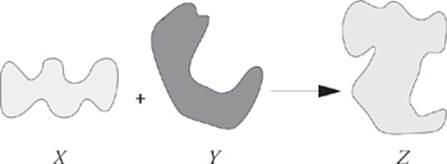
In the above reaction, molecules X and Y are the reactants and molecule Z is the product. However, the reaction won”t happen unless X and Y get together.
X and Y need a mutual “friend” that will help them get together in the same place at the same time so they can react and form Z. The mutual friend is an enzyme. Here”s a picture of an enzyme that would work nicely to get X and Y together:
Enzymes: If Ya Can”t Stand the Heat …
One way to accelerate a reaction is to heat up the substances involved. The problem with this is that the heat can potentially cause unintended reactions, which in turn damage the structure of the cell. A more specific way to accelerate a reaction within a cell depends on compounds that speed up chemical reactions. These compounds are called catalysts. Chemical reactions in cells are usually sped up by specific catalysts called enzymes.
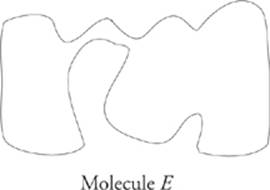
We”ll call the enzyme molecule E. If E is around, the reaction between X and Y occurs much more quickly than if E is not around. We call E a catalyst. Catalysts simply make chemical reactions occur faster. E”s job is to catalyze the reaction between X and Y.
Notice that the spaces on the top of molecule E match up with molecule X”s shape. The spaces on the bottom match up with molecule Y”s shape.
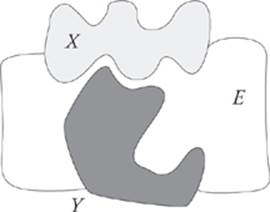
So if molecule E is floating around in the cytoplasm of a cell, X and Y have a good chance of getting together. Once they do, they react to form molecule Z.

When the reaction is finished, molecule E is still around, and is unchanged. It”s now free to go and find another pair of X and Y to catalyze another reaction between them. So here”s the first important fact to remember about an enzyme:
When an enzyme catalyzes a reaction, it is not used up in the reaction and therefore is reusable.
Remember how precisely molecules X and Y fit into molecule E in our example? Real reactants fit into enzymes just as precisely. This is sometimes referred to as the “lock and key” theory. In other words, the reactants fit into the enzyme as precisely as a key fits into a lock. The places where the reactants bind are called the active sites of the enzyme.
Because the fit is so precise, a particular enzyme in a cell can only catalyze a particular reaction. We say that the enzyme is specific for a particular set of reactants and a particular reaction. In our example above, enzyme E is specific to reactants X and Y. E will only catalyze the reaction between X and Y to form Z.
Here”s an enzyme called F.
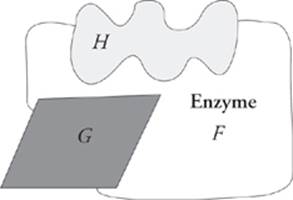
Enzyme F is specific to reactants G and H. It catalyzes only the reaction in which G and H combine to form some product. So here”s the second important fact to remember about an enzyme:
Enzymes are specific for particular reactions.
One other thing: Reactants in an enzyme-catalyzed reaction are called substrates. So molecules X, Y, G, and H would be referred to as substrates.
Enzymes Are Proteins
Enzymes are nothing more than proteins, which means they are organic molecules. They have specific three-dimensional shapes (like all proteins), and their shapes are what make them specific for particular reactions. If they lose their shapes (become denatured) they can no longer run reactions. One thing that can denature enzymes is heat. Heat destroys an enzyme”s three-dimensional shape and prevents it from catalyzing its reaction. Other things that can denature enzymes are acids and bases.
Enzymes are important because they help determine which particular chemical reactions a cell is going to run. Cells are like little bags of chemicals. Enzymes help determine which chemicals will react with one another to carry out the particular functions of a cell.
Sometimes enzymes need help to catalyze reactions. Molecules that help enzymes are called coenzymes. Coenzymes can help enzymes work faster, and some enzymes can”t work at all without coenzymes. What, specifically, are coenzymes? Vitamins. Vitamins are coenzymes. Can you see why getting the right vitamins in your diet is important? Without vitamins, many enzymes would be unable to function properly, and many chemical reactions would not occur. If these chemical reactions were not to occur, your body”s cells (and your body!) would not be able to work properly, if at all.
Quick Quiz #3
Fill in the blanks and check the appropriate boxes:
1. The fact that enzymes interact with substrate by physically fitting together has given rise to the phrase “_________________________ and ______________” theory.
2. Enzymes are known as organic ____________________.
3. When an enzyme has catalyzed a chemical reaction and the products are formed, the enzyme itself [ ![]() is
is ![]() is not ] consumed and is [
is not ] consumed and is [ ![]() unavailable
unavailable ![]() available ] to catalyze additional reactions.
available ] to catalyze additional reactions.
4. The location on an enzyme where substrate binds is called the ________________________.
Correct answers can be found in Chapter 15.
Key Words
unicellular
multicellular
cell wall
cell membrane
cytoplasm
cytosol
organelles
nucleus
chromosomes
plants
cellulose
bacteria
peptidoglycan
fungi
chitin
phospholipids
aqueous
selectively permeable
diffusion
dynamic equilibrium
facilitated diffusion
active transport
bulk transport
endocytosis
exocytosis
vesicle
phagocytosis
pinocytosis
osmosis
hypertonic
hypotonic
isotonic
eukaryotic
prokaryotic
vacuole
ribosomes
smooth endoplasmic reticulum
rough endoplasmic reticulum
golgi apparatus
mitochondria
lysosomes
centrioles
nucleus
nucleolus
cell membrane
enzyme
catalyst
active sites
substrates
denatured
coenzymes
vitamins
Summary
• A eukaryotic cell has a cell wall and/or a cell membrane forming its outer layer, cytoplasm where the organelles are located, and a nucleus where the chromosomes are located.
• Plants, bacteria, and fungi have cell walls. Animal cells do not. All types of cells have cell membranes.
• Substances can cross a cell membrane by diffusion, facilitated diffusion, active transport, and bulk transport.
• Diffusion is the movement of a substance from an area of high concentration to an area of low concentration until a dynamic equilibrium is reached.
• In simple diffusion, the molecules must be hydrophobic.
• In facilitated diffusion, the molecules that move are hydrophilic, and need assistance from special membrane proteins.
• Active transport requires energy and can move materials from a low concentration to a high concentration.
• Bulk transport involves the movement of large molecules across the cell membrane.
• Osmosis is the movement of water across a cell membrane.
• A eukaryotic cell”s organelles are found in the cytoplasm. Each organelle has a unique structure and function within a cell.
• Enzymes, or special proteins, help speed up the reaction between specific substrates within a cell.